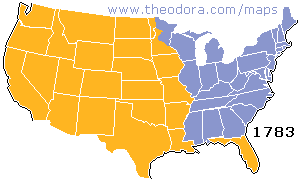This map is courtesy of www.theodora.com/maps, used with permission.
 At the beginning of 1800, the United States was formally comprised of sixteen states: the original thirteen colonies having been recognized as independent by the Treaty of Paris in 1783 and the states of Vermont, Kentucky and Tennessee having been added to the union by 1796. But American trappers and settlers were busily expanding to other areas, and the country was growing rapidly. Americans did not question their right to colonize vast expanses of North America beyond their country's borders. By the mid-1840s, United States expansionism was expressed in terms of "manifest destiny," and by the end of the nineteenth century, the United States had aquired all of its current territory through a series of wars and peaceful acquisitions:
At the beginning of 1800, the United States was formally comprised of sixteen states: the original thirteen colonies having been recognized as independent by the Treaty of Paris in 1783 and the states of Vermont, Kentucky and Tennessee having been added to the union by 1796. But American trappers and settlers were busily expanding to other areas, and the country was growing rapidly. Americans did not question their right to colonize vast expanses of North America beyond their country's borders. By the mid-1840s, United States expansionism was expressed in terms of "manifest destiny," and by the end of the nineteenth century, the United States had aquired all of its current territory through a series of wars and peaceful acquisitions:
- In 1803, the United States made the the Lousiana Purchase, aquiring a huge tract of land (530 million acres!) from Napoleon Bonaparte. This land makes up approximately 22 percent of the current United States and contained parts or all of present-day Arkansas, Missouri, Iowa, Minnesota, North Dakota, South Dakota, Nebraska, New Mexico, northern Texas, Oklahoma, Kansas, portions of Montana, Wyoming, and Colorado, portions of southern Manitoba, southern Saskatchewan and southern Alberta, and Louisiana. Not all of this land was kept, later being ceded to Great Britain and Spain in exchange for other territory.
- West Florida was made a U.S. possession in 1810 by President James Madison.
- The Red River Basin, part of current-day Minnesota and North Dakota, was acquired in the Anglo-American Convention of 1818, a treaty with Great Britain which resolved boundry issues, set the US/Canadian boundary along the 49th parallel, and allowed for joint control of the Oregon Country.
- East Florida was acquired in the Adams-Onis Treaty of 1819 with Spain. The treaty that gained East Florida also included Spain's surrender of any claims to the Oregon Country.
- The Oregon Country was jointly controlled by the U.S. and Great Britain until 1846 when the Oregon Treaty divided that territory also at the 49th parallel. This created the Oregon Territory, which includes present-day Oregon, Washington and Idaho, as well as parts of Montana and Wyoming.
- The Republic of Texas, which had gained its independence from Mexico in 1836, voted that year to be annexed by the United States. However it was nearly 10 years before the annexation of Texas took place. President John Tyler signed a treaty of annexation with Texas in 1844; congress approved it in 1845 and Texas became the 28th state later that year.
- Mexican leader Antonio López de Santa Anna warned that the annexation of Texas would be "equivalent to a declaration of war against the Mexican Republic." Mexico had never formally acknowledged Texas independence and considered it a matter of national pride to fight for what it considered a rebel province. Thus started the Mexican-American war. The United States defeated Mexico and in the subsequent Treaty of Guadalupe Hidalgo, Mexico ceded to the United States parts of what are Texas, Colorado, Arizona, New Mexico and Wyoming, and the whole of California, Nevada and Utah. They also recognized the Rio Grande as Texas' Southern border.
- Less than five years after the Mexican Cession, the United States made the Gadsden Purchase of 1853, aquiring a strip of land along the U.S.-Mexico border, now in New Mexico and Arizona. This territory was later used for the southern transcontinental railroad.
- In 1867, the United States purchased Alaska from Russia.
- Hawaii was annexed in 1898 upon the request of a government made up primarily of American and European businessmen who had overthrown the Kingdom of Hawaii.
- Puerto Rico, Guam, the Philippines, and Cuba were ceded by Spain to the United States after the Spanish-American War in 1898. All four of these areas were under United States Military Government for extended periods. Cuba became an independent nation in 1902. The Philippines became an independent nation in 1946.
Did you find this review helpful?